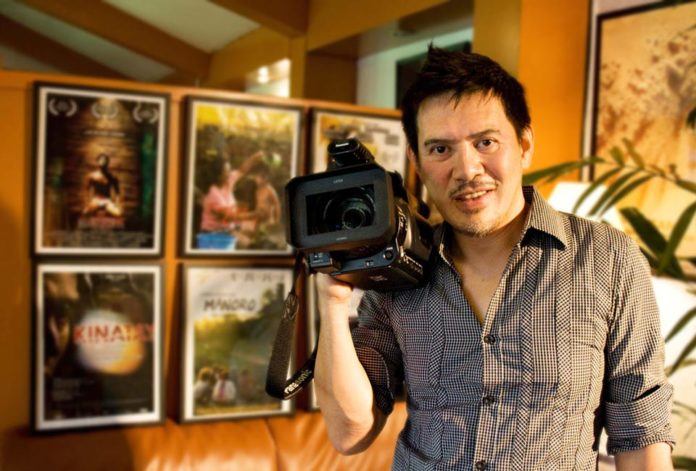His parents wanted him to become a medical doctor, but fate had a different vision for him. Brillante Mendoza, 2009 Cannes Film Festival best director, missed his entrance exam for a pre-medicine course in UST, which turned out to be a blessing in disguise.
“I arrived late for the B.S. Psychology entrance exam so I was not able to take it. At that time, only the slots for Advertising were available,” Mendoza said.
Having missed the bus for a profession in the medical arts, Mendoza instead took the flight for a career in the visual arts. His parents initially disapproved of his decision to study Advertising, but eventually supported him as he started studying at the old College of Architecture and Fine Arts in 1978.
It was in the University where he laid the building blocks for his now fledging career as a film director. Mendoza was a regular in photography and television production competitions on campus. He won a handful, including first place in a campus photography competition, group exhibitions, and painting contests.
“My fondest memories of my UST days were the midnight preparations I had with my classmates for those competitions,” the Pampanga native told the Varsitarian.
Way to the top
In 1982, Mendoza graduated from the University. It was also the beginning of his gradual rise to the top.
Mendoza started as an employee of the graphic agency, Studio Five, and sidelined as a set designer for feature films, television shows, and advertisements. He also considered pursuing a master’s degree in Advertising in the University, but only lasted for one semester after he lost interest.
Later on, Mendoza learned the ropes from top-flight Philippine cinema directors after taking a filmmaking scholarship at Ateneo de Manila University. He worked for: Peque Gallaga as art director in Virgin Forest (1985); Chito Roño as production designer in Private Show (1986); and William Pascual as production designer in Naghihilom ang Sugat (1986) and Takaw Tukso (1986). Takaw Tukso earned Mendoza a Gawad Urian for Best Production Design in 1987.
“I imagined myself in their shoes while I was working with these directors,” Mendoza said. “I discovered the beauty of detailed shots and angles from Peque Gallaga, Celso Ad Castillo influenced me with his spontaneity, and William Pascual taught me effective story telling.”
Mendoza, however, grew tired after three years in the film industry, and instead worked as a production designer for television shows and commercials in the 1990s.
Return to film
In 2005, Mendoza returned to the film industry and finally directed his first film. And he did an excellent job.
His first film Masahista reaped awards and recognition overseas, including the interfaith award at the Brisbane International Film Festival in Australia and the audience award at the Toronto International Gay and Lesbian Film Festival in Canada.
“The success of Masahista was unexpected,” Mendoza said. “I was 45 at that time, which I considered too late for me to start out as a director. But the success was encouraging, and it entirely changed my views on filmmaking.”
The success of his directorial debut did not cause Mendoza to rest on his laurels. Rather, it all the more drove him to perfect his craft and produce more socially conscious films that depict real-life situations of the masses.
His next films Kaleldo (2006), Foster Child (2007), Tirador (2007), and Serbis (2008) all drew critical acclaim not only in the Philippines, but also abroad. Serbis was also the first Filipino full-length film to compete at the Cannes Film Festival in France since Lino Brocka’s Bayan Ko Kapit sa Patalim in 1984.
Last May 24, years of hard work finally paid off when Kinatay won him the 2009 best director award at Cannes.
“Winning an award at Cannes must be the biggest thing I have ever achieved in my life. Just the fact that my films were included in the festival is overwhelming, and two years in a row at that,” Mendoza said.
His films are apparently inspired by the realist style, a style he learned from Francois Truffaut’s 1959 Italian film, The 400 Blows, about the unjust treatment of juvenile offenders in 50’s France.
“I base my films on real-life situations, on what I see around my environment, and on my experiences, this is my way of exposing social issues,” Mendoza said.
Hindsight is truly 20-20. Mendoza may not be saving lives now as a doctor, but he is playing a big part in echoing the plight of the Philippine masses. Indeed, the medical profession’s loss is the Philippine film industry’s gain.
Brilliance at ‘golden age’
For acclaimed independent film director Brillante Mendoza, turning 50 is just a number.
“It’s just age, it’s doesn’t really matter to me. I just want to celebrate and I want to share all the blessings and achievements that I’ve had for the past five years since I started being a filmmaker,” he was quoted in the media as saying.
The director is also gearing up to make his official debut to the international movie scene.
The filmmaker is keeping himself busy with another movie, tentatively titled Captured, starring notable French actress Isabelle Huppert and produced by Germany and France.
Huppert was head of the jury at the 62nd Cannes Film Festival in 2009, when Brillante was named Best Director for Kinatay.
“It’s about the hostage taking [situation] in Mindanao and Isabelle would be one of the victims,” the director said.
The cast will also include celebrated indie actors Coco Martin—whose acting in Kinatay impressed Huppert—Ronnie Lazaro, and Ping Medina. With reports from Danielle Clara P. Dandan










